Key Facts
- The Great Basin gopher snake is a subspecies of the northern pine snake. It is impressively adaptable in terms of its habitat choices and is nonvenomous.
- Colorado bullsnakes are also nonvenomous and are a favorite among exotic pet owners due to their docile nature.
- Northern water snakes can live in lakes, rivers, streams, or swamps. They can also tolerate brackish water and are capable of remaining underwater for 90 minutes.
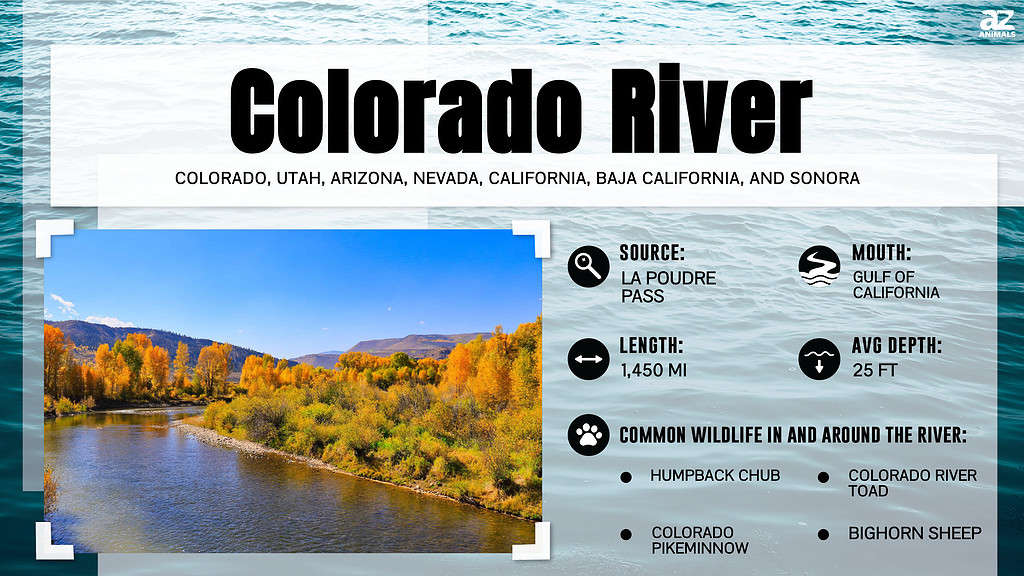
The Colorado River is known for hosting a lot of wildlife due to the diversity of its environment, which includes mammals, birds, fish, reptiles, amphibians, and even plants and vegetation. Even if it is a heavily-regulated river for industrial and recreational purposes, it is still a habitat for many wonderful life forms.
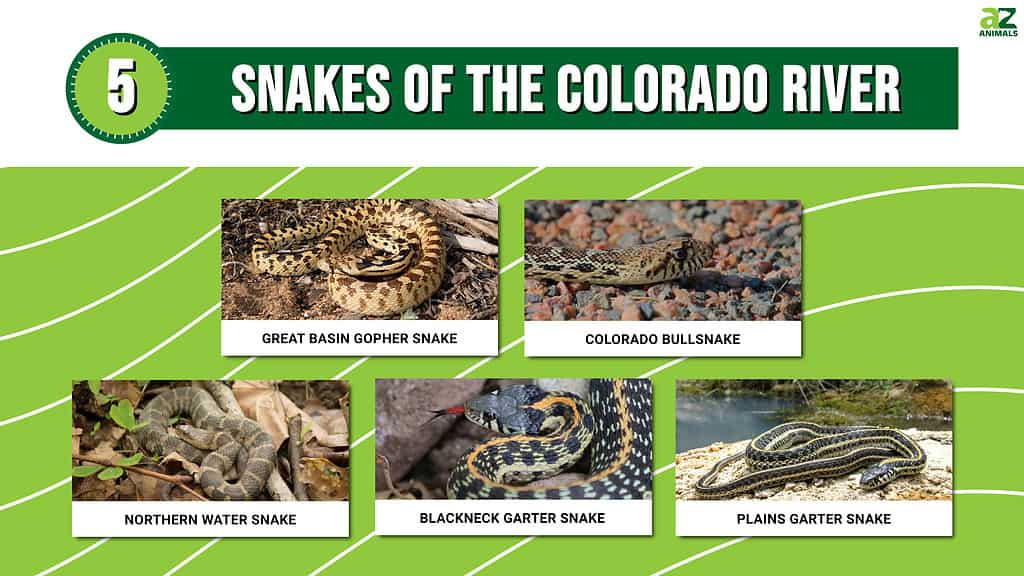
Reptiles won’t be out of the picture among the animals living within or around the Colorado River. Within the Colorado River and its surrounding area alone, 47 species of reptiles already exist, making up an average of 67 reptiles found in the state of Colorado. The most prevalent of these reptiles are snakes that are located along the river corridor.
Today, we’re going to talk about the five snakes of the Colorado River and their diet, habitat, behavior, and other unique and exciting features that are yet unknown about them.
1. Great Basin Gopher Snake
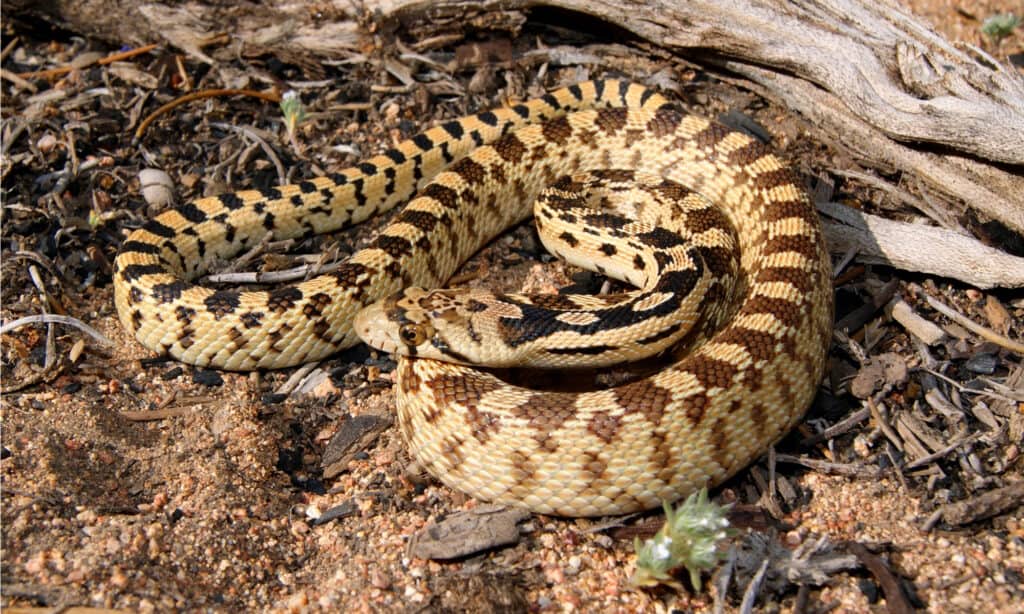
The Great Basin gopher snake is a subspecies of the northern pine snake.
©Matt Jeppson/Shutterstock.com
| Great Basin Gopher Snake | Details |
|---|---|
| Scientific name | Pituophis catenifer deserticola |
| Length | Up to 4.5 feet |
| Diet | Insects, eggs, lizards, birds |
The Great Basin gopher snake is a subspecies of the northern pine snake and can live in various habitats such as dry sandy areas, sea levels up to 9,000 feet, plains, pine woodlands, deserts, grass, cultivated fields, and in and around river corridors. Great Basin gopher snakes are pale brown-colored snakes with rows of large square blotches, reddish-brown or black blotches in the back, and smaller ones on the sides, while the undersides are cream-colored with small dark spots.
One interesting feature about these burrowing snakes is that they have a filament of cartilaginous flesh in front of their breathing passages in the mouth. So when the snake’s mouth is opened out of threat, the filament is raised, which causes its breath to exhale and make a loud hissing noise.
These nonvenomous snakes do not directly bite prey but instead are constrictors. They are good climbers, burrowers, and swimmers, and they can also imitate the hissing sounds of a rattlesnake by rapidly vibrating their tails to scare away potential predators. Despite trying to look dangerous, they do not threaten humans as their diet consists of only insects, eggs, lizards, birds, and small mammals such as mice. They can also initiate cannibalism by eating other snakes.
2. Colorado Bullsnake
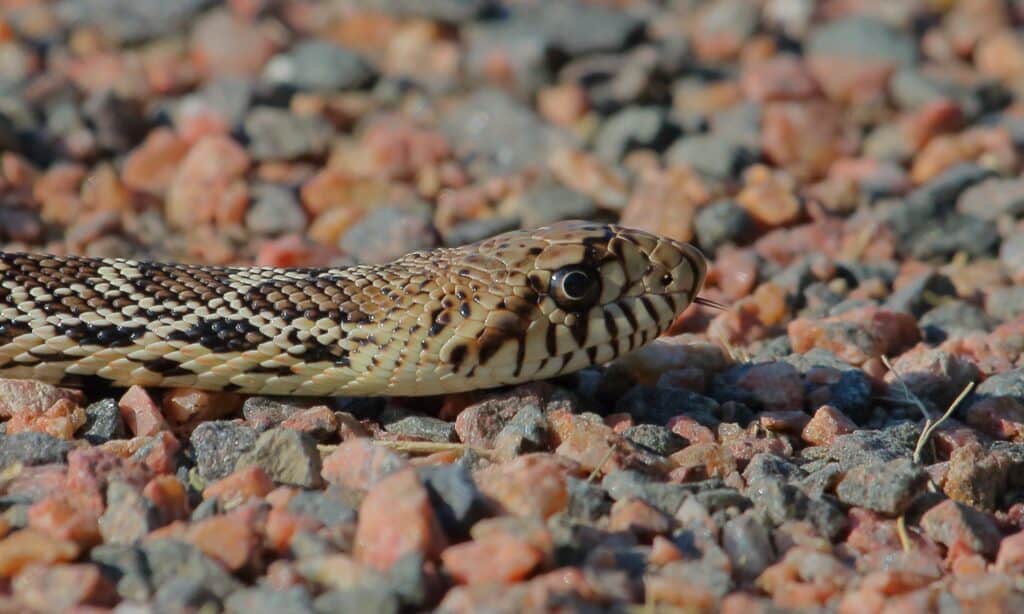
Colorado bullsnakes have a yellowish base color with reddish-brown to black blotches on the back.
©iStock.com/tami1120
| Colorado Bullsnake | Details |
|---|---|
| Scientific name | Pituophis catenifer sayi |
| Length | Up to 6 feet |
| Diet | Small mammals, birds, eggs |
Colorado bullsnakes are considered to be among the largest and most common snakes in Colorado. They also imitate the hissing sound of rattlesnakes when threatened. Despite their vast and ferocious size, they are also not a threat to humans as they are nonvenomous and may even help in controlling the rodent population in some industrial areas as they feed on rats, mice, ground squirrels, rabbits, and other invasive species of snakes.
These huge snakes are primarily found in prairies, grasslands, and meadows and may also be found in nearby areas around the Colorado River. They have a yellowish base color with reddish-brown to black blotches on the back, and their bellies are cream-colored with brown or blackish botches. Their tails are boldly patterned with dark brown and tan.
These bullsnakes can also be kept as pets as they are easy to handle and hold in captivity. According to exotic pet keepers with snakes, they are enjoyable and rewarding to keep because of their docile and friendly behavior if appropriately handled.
3. Northern Water Snake
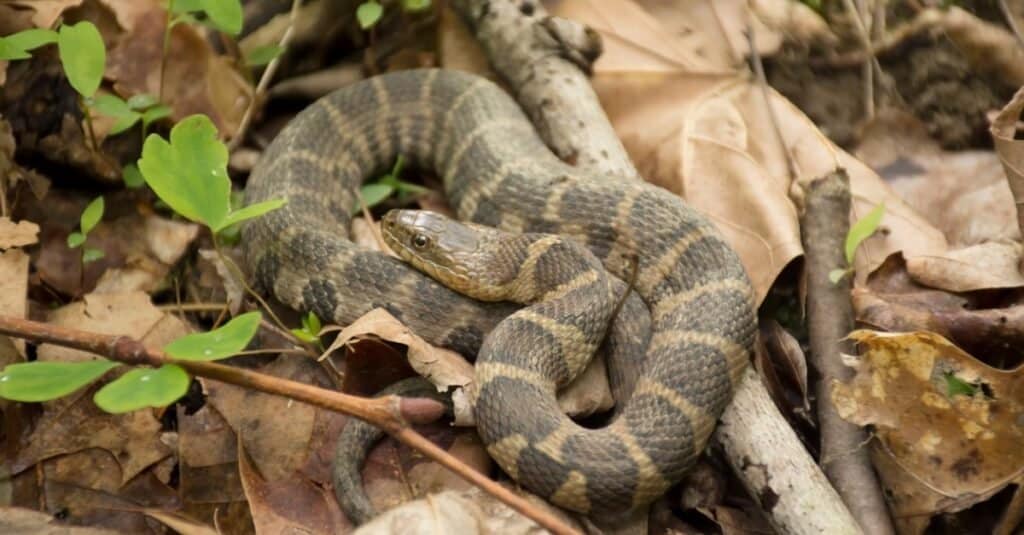
The northern water snake can be found in aquatic habitats such as rivers, lakes, swamps, ditches, streams, and marshes.
©iStock.com/IcemanJ
| Northern Water Snake | Details |
|---|---|
| Scientific name | Nerodia sipedon |
| Length | Up to 4 feet |
| Diet | Fish, frogs, birds, mammals, worms, leeches, tadpoles |
One of those nonvenomous snakes, the northern water snake, can be found in aquatic habitats such as rivers, lakes, swamps, ditches, streams, and marshes. Northern water snakes can also live in brackish water areas with a salinity level of 12 ppt (parts per thousand) or may hide in branches, reeds, piles of sticks, or in the river corridors.
These snakes vary in color and may sometimes be brown, reddish, grey, or black. They have dark cross bands on their necks and blotches all over their bodies, which gradually darken as they age. One unique factor about these snakes is that they can stay underwater for an hour and a half without returning to the surface to breathe.
Northern water snakes are active both day and night to hunt for prey. They feed on fish, frogs, birds, mammals, worms, leeches, tadpoles, salamanders, and crayfish. They are sometimes mistaken for venomous cottonmouths as they are deemed to have almost the same appearance, except that the cottonmouth is venomous and the northern water snake is not. When provoked, they can bite immediately and release a foul-smelling odor to defend themselves.
4. Blackneck Garter Snake
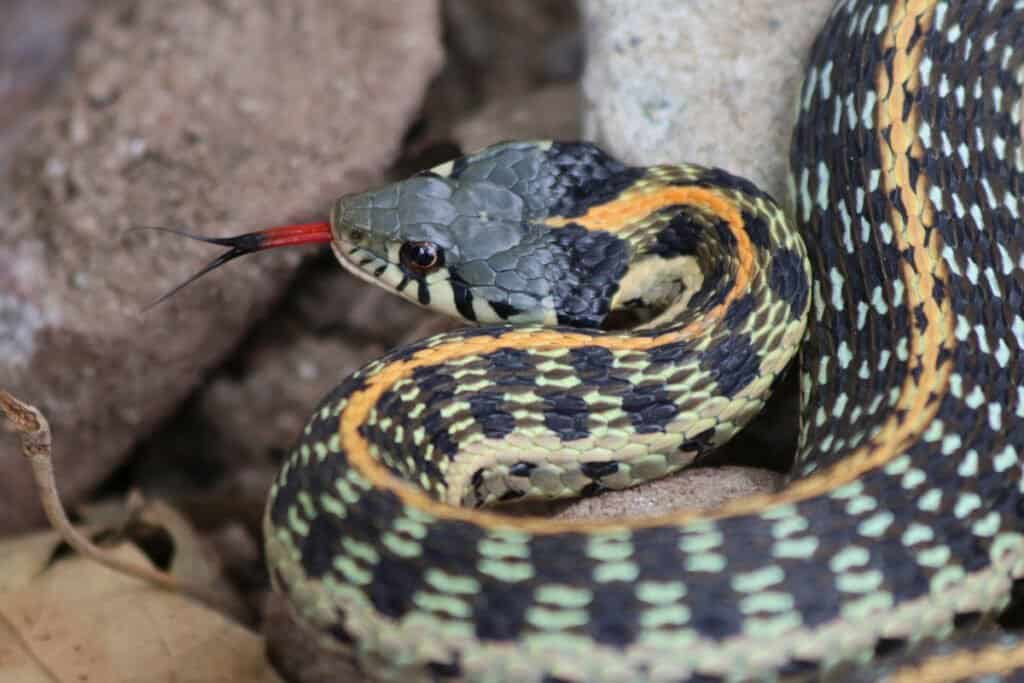
The blackneck garter snake is dark olive-colored with orange-yellow stripes situated across the middle of its body from the top.
©Creeping Things/Shutterstock.com
| Blackneck Garter Snake | Details |
|---|---|
| Scientific name | Thamnophis cyrtopsis |
| Length | Up to 3.5 feet |
| Diet | Amphibians, earthworms, small fish, other snakes |
A rare species in the state of Colorado, the blackneck garter snake is dark olive-colored with orange-yellow stripes situated across the middle of its body from the top. Its underside is cream-colored with a light shade of gray. Blackneck garter snakes can also be olive-gray or olive-brown in color. These snakes are semi-aquatic creatures and may live in areas near bodies of water, such as river corridors.
These are also nonvenomous snakes, but their saliva does contain toxins that can cause human skin to react mildly when bitten. However, this is still not a cause for concern as they rarely bite when necessary or in the presence of a potential threat. One of the most interesting things about these snakes is their ability to release a foul-smelling odor from their anal glands, just like northern water snakes, when they are threatened.
5. Plains Garter Snake
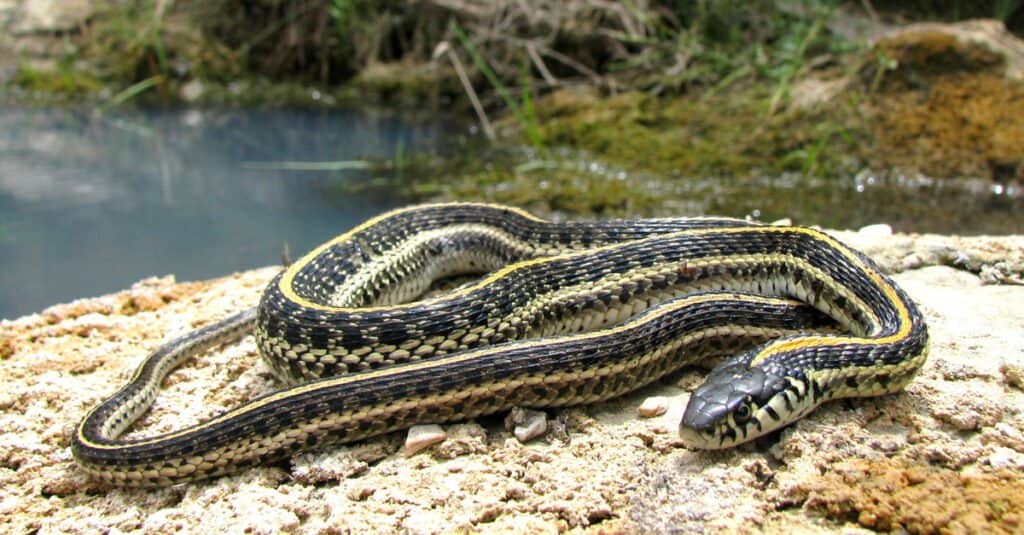
The plains garter snake is a slender, medium-sized snake that is mildly venomous.
©Joe Farah/Shutterstock.com
| Plains Garter Snake | Details |
|---|---|
| Scientific name | Thamnophis radix |
| Length | Up to 3 feet |
| Diet | Frogs, toads, salamanders, slugs, tadpoles |
A slender, medium-sized snake that is mildly venomous is what we can describe the plains garter snake as. While mildly venomous, plains garter snakes are still not harmful as the toxins in their saliva are only for their prey and do not pose a threat to humans.
They have distinctive orange or yellow stripes from head to tail, with a gray or green color on the rest of their bodies. They are found along the edges of streams, lakes, marshes, and rivers and may also be found in grasslands and other wetlands.
These snakes are considered one of the most cold-tolerant snakes as they even come out of their burrows to bask in the sun during warm winter days. They are also solitary creatures but prefer to hibernate in small groups. These garter snakes feed on frogs, toads, salamanders, slugs, and tadpoles and may even eat small mammals and birds.
Summary Of The 5 Snakes Of The Colorado River
| # | Snake | Length | Venomous or Non-Venomous |
|---|---|---|---|
| 1 | Great Basin Gopher Snake | Up to 4.5 ft | Non-Venomous |
| 2 | Colorado Bullsnake | Up to 6 ft | Non-Venomous |
| 3 | Northern Water Snake | Up to 4 ft | Non-Venomous |
| 4 | Blackneck Garter Snake | Up to 3.5 ft | Non-Venomous |
| 5 | Plains Garter Snake | Up to 3 ft | Non-Venomous |
Other Reptiles Found Near The Colorado River
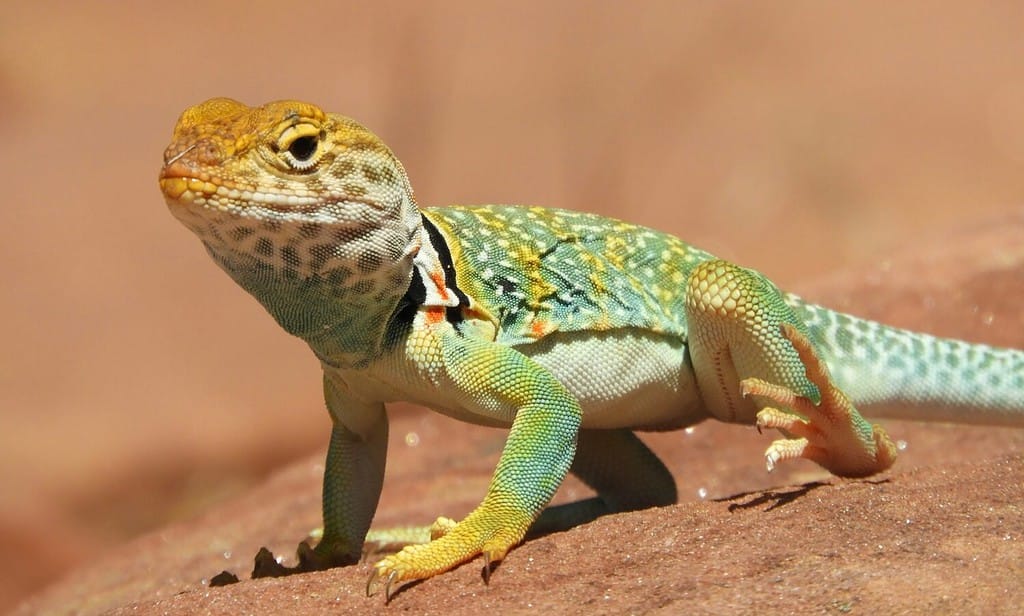
Eastern collared Lizard has colors most apparent in males during mating season.
©PDeluca/Shutterstock.com
Endemic to North America is the Eastern collared lizard, a bright, colorful lizard with a long tail that goes by quite a few names – common collared lizard, mountain boomer, and yellow-headed collared lizard – and can be distinguished by the two black rings around its neck. This vibrant reptile hibernates in winter but can be found during the warmer months in rocky areas and is relatively large, with males reaching about 4.5 inches and females reaching 4 inches. Although rather docile and not venomous, these lizards do inflict a very painful bite that can break the skin. It is also not recommended that they be kept as pets as they do not do well in captivity and won’t survive.
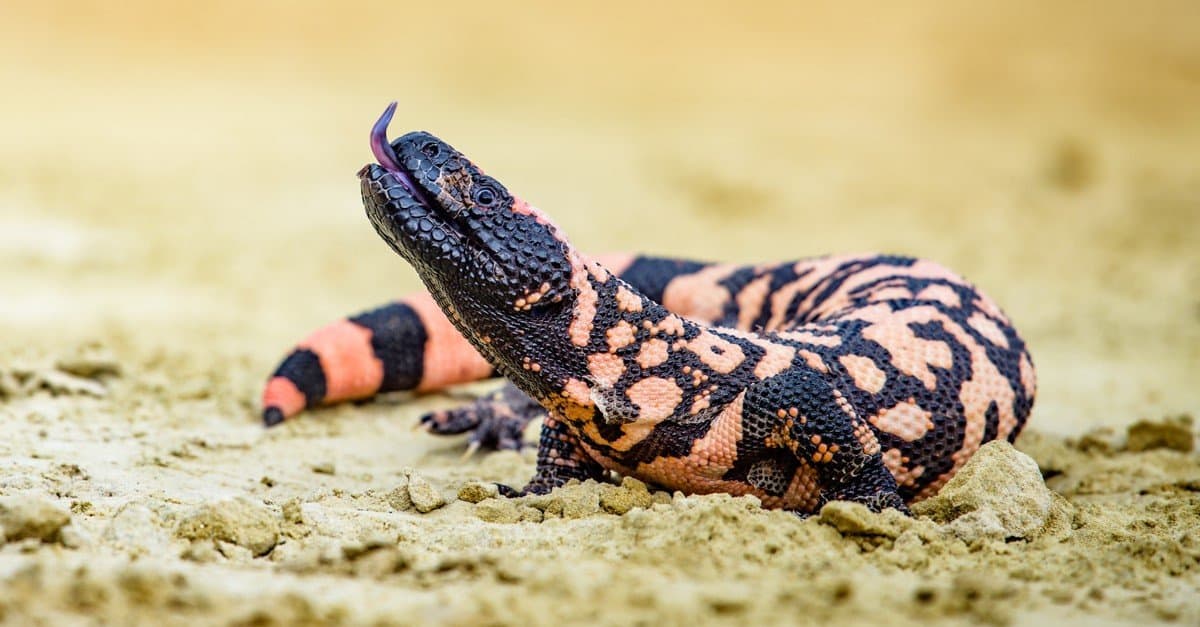
These lizards were named after the Gila River.
©Vaclav Sebek/Shutterstock.com
The Gila Monster is the only venomous lizard in the United States and it can be found in areas along the Colorado River. Generally found in desert areas close to water, as they depend on water resources, it can be at the far western edge of Grand Canyon National Park, as well as places in Arizona, New Mexico, southeast California, and southern Nevada. Named after the Gila River, this reptile is the largest lizard in the United States and can grow between 20 to 22 inches in length and can weigh between 3 to 5 pounds.
Although it is rare that they will ever bite a person as they are not very aggressive, they do have a highly toxic venom that can cause serious respiratory issues, eventually leading to paralysis. Unlike the rattlesnake, which uses fangs to inject its venom, this lizard must chew through the flesh of its victim in order for the venom, which is on the roof of its mouth, can travel down the grooves in its teeth and make its way into the flesh.
Summary of 5 Snakes Of The Colorado River
| Rank | Snake |
|---|---|
| 1 | Great Basin Gopher Snake |
| 2 | Colorado Bullsnake |
| 3 | Northern Water Snake |
| 4 | Blackneck Garter Snake |
| 5 | Plains Garter Snake |
The photo featured at the top of this post is © iStock.com/manuellacoste
Discover the "Monster" Snake 5X Bigger than an Anaconda
Every day A-Z Animals sends out some of the most incredible facts in the world from our free newsletter. Want to discover the 10 most beautiful snakes in the world, a "snake island" where you're never more than 3 feet from danger, or a "monster" snake 5X larger than an anaconda? Then sign up right now and you'll start receiving our daily newsletter absolutely free.
Thank you for reading! Have some feedback for us? Contact the AZ Animals editorial team.







